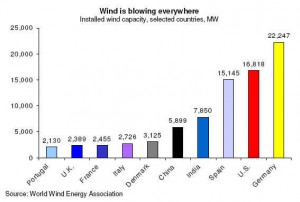Why Too Much Of A Good Thing Could Be Bad
From the June 2008 issue of EEnergy Informer.
What happens when you have a lot of wind on the network and the wind stops blowing?
Currently, renewable energy resources are in vogue, everyone wants more of them, asap. And in some places, they are getting quite a bit of it, principally wind and solar energy. Last year, according to the American Wind Energy Association, US wind power sector grew around 45% by adding over 5,000 MW of new capacity. Global Wind Energy Council, a wind trade group based in Brussels, says that the corresponding figure worldwide was around 20,000 MW requiring a $36 billion investment. More is in the pipeline.
The same is happening to solar, currently not as big as wind, but growing at a fast trajectory (see lead article in this issue). The more the merrier, right? As it turns out, like everything else, even a good thing can turn out to be bad if you get too much of it. That reality is beginning to be a new concern for intermittent renewables.
The problem for solar-based technologies is that one can collect the heat or convert sunshine to electricity when the sun shines, which would be predictable if it were not for clouds, fog, and storms. As the proportion of solar-generated power increases, thermal storage becomes a big plus. Solar technologies, however, enjoy one big advantage over wind because generation tends to be strongly correlated with periods of high demand, usually on hot summer afternoons.
Wind, on the other hand, does not necessarily blow when it is most needed, and not usually close to the load centers. Forecasting when it blows and at what speed has become more critical as significant amounts of capacity are added. Yet, wind forecasting – like weather – remains part art and part science. When the forecasts are good, the grid operator can schedule compensating thermal generation or rely on pumped-hydro or other means to manage the fluctuations in wind-generated power. But when the forecast is off, as sometime happens, it could creates havoc and cause wholesale prices to spike erratically.
An example of what happens when the wind forecast turns out to be inaccurate happened on 26 Feb 08 in Texas. A cold front moved unexpectedly into West Texas spinning some 1,700 MW of turbines. The grid operator, Electric Reliability of Texas (ERCOT), ramped down thermal generation to accommodate the wind-generated power. Hours later and with no warning, the winds subsided, dropping generation to 300 MW.
To balance load, ERCOT had to declare an emergency asking large customers with interruptible loads or demand response to shed load. In the mean time, it had to purchase replacement energy on short notice, which caused wholesale prices in the affected area to surge to $1,055/MWh while average prices elsewhere in the system jumped to around $300/MWh. Two days later, ERCOT prices hit the new allowed ceiling of $2,250/MWh during a similar episode, making for good newspaper headlines.
Referring to the problem, an embarrassed Kant Saathoff, VP of System Operations at ERCOT, said uncertainties in wind output, “showed us we need much better wind forecasting tools.†Nobody could disagree that improved forecasting would be a huge help but everyone knows that we cannot predict weather with perfect accuracy no matter how hard we try. Geothermal energy, by contrast, is a base-load source of power and does not suffer from intermittency.
Needless to say, integration of intermittent renewables will become more of an issue as their percentage within networks grow. In countries like Germany, Denmark and Spain, this phenomenon has become noticeable and a source of increasing concerns. In Germany, the transmission network has been reinforced to bring additional wind generated power from wind-rich areas to major load centers. Additionally, thermal plants originally designed to operate as base-load units are now cycled up and down to accommodate the fluctuating wind-generated power.
In Spain, another country with significant new wind capacity, the grid operator, Red Electrica de Espana (REE), has put a 30% limit on the share of wind power specifically to prevent grid reliability problems such as those experienced in West Texas. Spain, which already has an installed wind capacity exceeding 15,000 MW has ambitious plans to reach 20,000 MW by 2010 and 30,000 by 2030. Wind developers are naturally concerned about the new artificial constraint.
REE, for its part says that it is merely trying to maintain system reliability and avoid huge price spikes in the wholesale market. The Iberian Peninsula effectively operates as an electrical island with only 5% interconnection capacity to neighboring countries. REE has suggested that strengthening the interconnections between Spain and neighboring France would be one way to make Spain less vulnerable to fluctuations in wind-generated energy.
Leave a Reply
You must be logged in to post a comment.

